lock FORD FIESTA 2007 Owner's Manual
[x] Cancel search | Manufacturer: FORD, Model Year: 2007, Model line: FIESTA, Model: FORD FIESTA 2007Pages: 1226, PDF Size: 61.26 MB
Page 139 of 1226
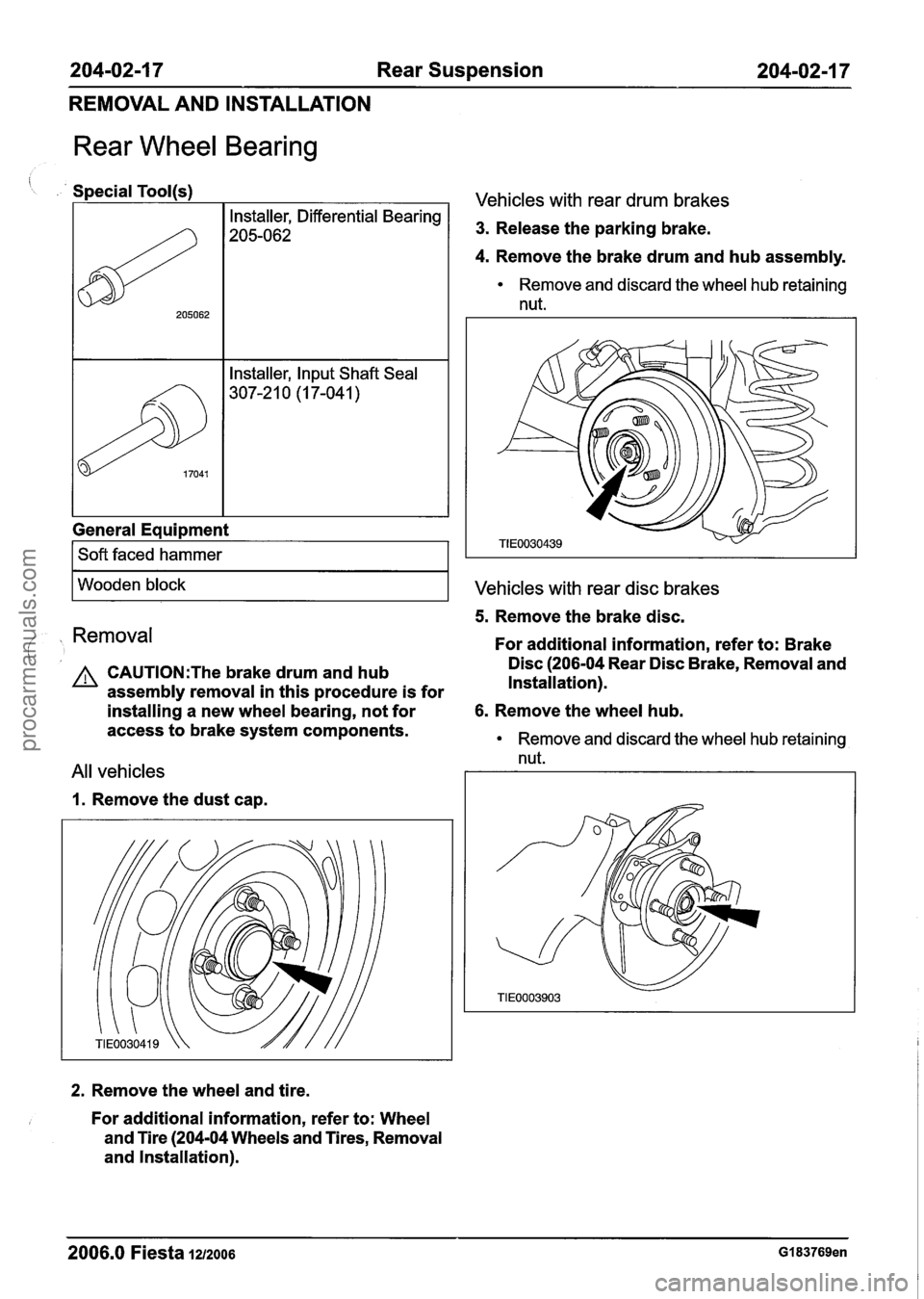
204-02-1 7 Rear Suspension 204-02-1 7
REMOVAL AND INSTALLATION
Rear Wheel Bearing
Special Tool(s)
General Equipment
17041
I Soft faced hammer I
Installer, Input Shaft Seal
307-2 1 0 (1 7-04 1 )
Vehicles with rear drum brakes
3. Release the parking brake.
4. Remove the brake drum and hub assembly.
Remove and discard the wheel hub retaining
nut.
I Wooden block I Vehicles with rear disc brakes
i , Removal
CAUTI0N:The brake drum and hub
assembly removal in this procedure is for
5. Remove the brake disc.
For additional information, refer to: Brake
Disc
(206-04 Rear Disc Brake, Removal and
Installation).
installing a new wheel bearing, not for
6. Remove the wheel hub.
access to brake system components.
Remove and discard the wheel hub retaining
nut.
All vehicles
1. Remove the dust cap.
2. Remove the wheel and tire.
For additional information, refer to: Wheel
and Tire
(204-04 Wheels and Tires, Removal
and installation).
2006.0 Fiesta 1212006 GI 83769en
procarmanuals.com
Page 140 of 1226
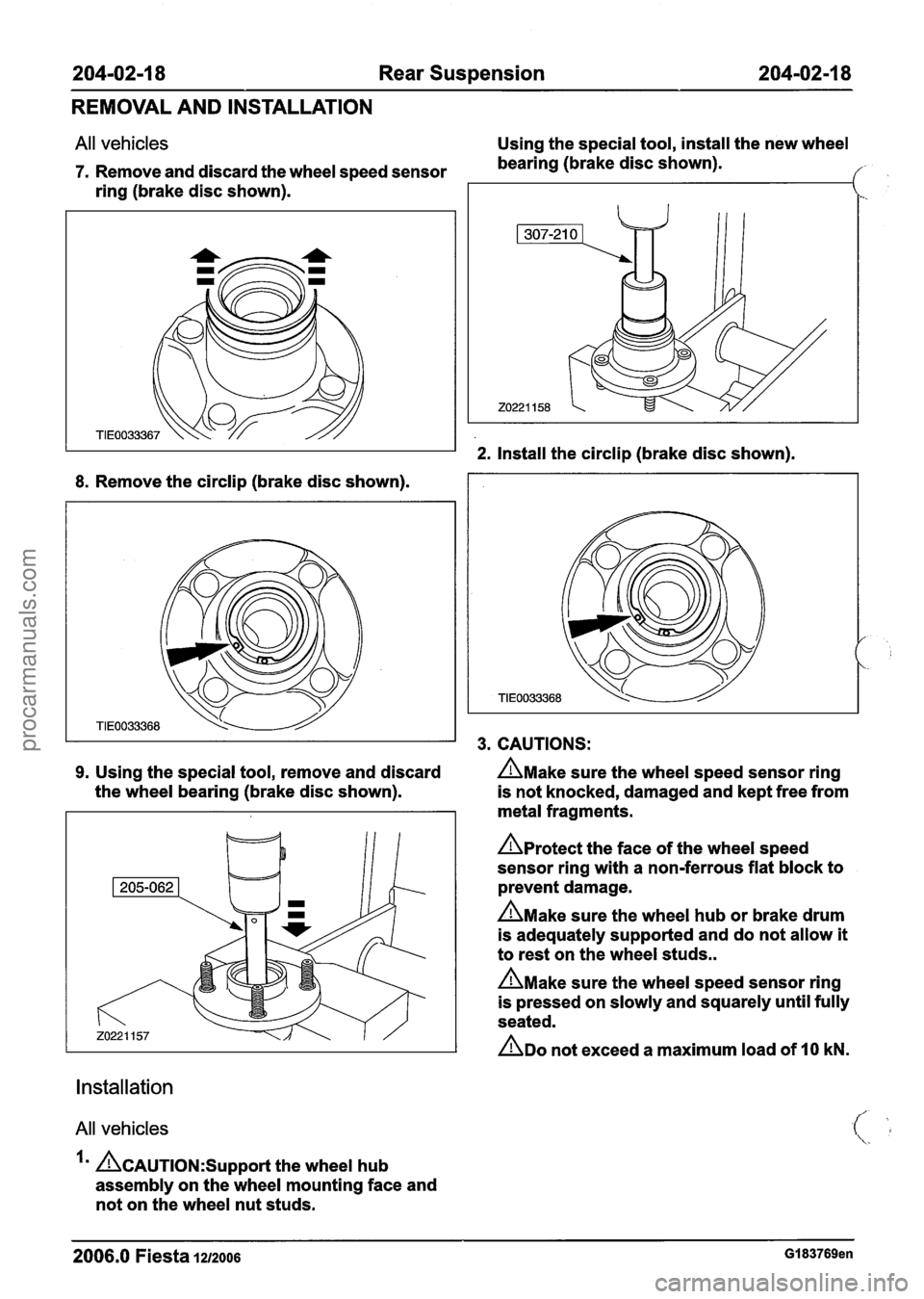
204-02-1 8 Rear Suspension 204-02-1 8
REMOVAL AND INSTALLATION
All vehicles Using the special tool, install the new wheel
7. Remove and discard the wheel speed sensor bearing (brake
disc shown).
ring (brake disc shown).
2. Install the circlip (brake disc shown).
8. Remove the circlip (brake disc shown).
3. CAUTIONS:
9. Using the special tool, remove and discard AMake sure the wheel speed sensor ring
the wheel bearing (brake disc shown).
is not knocked, damaged and kept free from
metal fragments.
A~rotect the face of the wheel speed
sensor ring with a non-ferrous flat block to
prevent damage.
A~ake sure the wheel hub or brake drum
is adequately supported and do not allow
it
to rest on the wheel studs..
AMake sure the wheel speed sensor ring
is pressed on slowly and squarely until fully
seated.
ADO not exceed a maximum load of 10 kN.
Installation
All vehicles
&AUTION:SU~~O~~ the wheel hub
assembly on the wheel mounting face and
not on the wheel nut studs.
2006.0 Fiesta 1212006 GI 83769en
procarmanuals.com
Page 141 of 1226
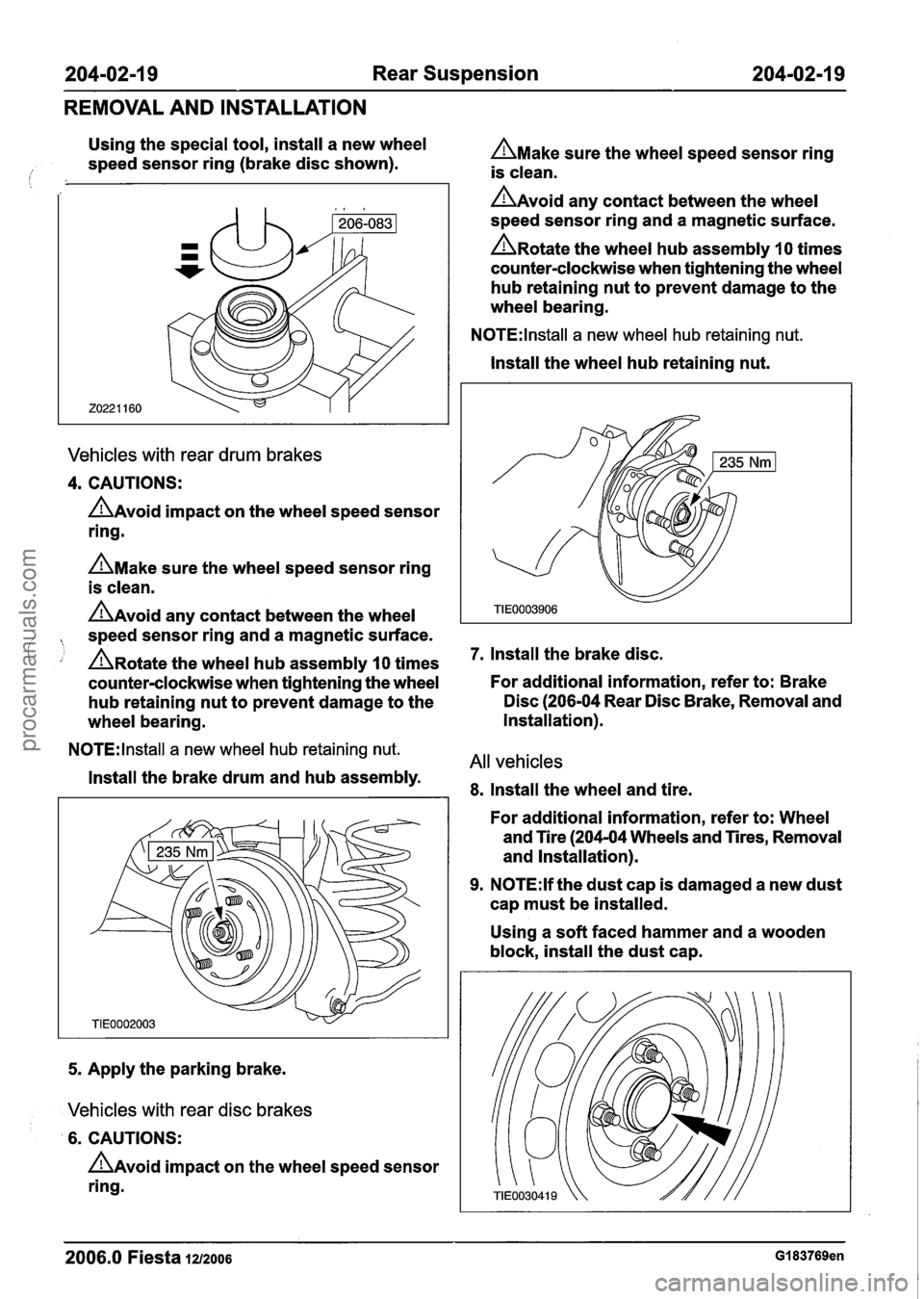
204-02-1 9 Rear Suspension 204-02-1 9
REMOVAL AND INSTALLATION
Using the special tool, install a new wheel
speed sensor ring (brake disc shown).
Vehicles with rear drum brakes
4. CAUTIONS:
AAvoid impact on the wheel speed sensor
ring.
AMake sure the wheel speed sensor ring
is clean.
AAvoid any contact between the wheel
, speed sensor ring and a magnetic surface.
' , A~otate the wheel hub assembly 10 times
counter-clockwise when tightening the wheel
hub retaining nut to prevent damage to the
wheel bearing.
N0TE:lnstall a new wheel hub retaining nut.
Install the brake drum and hub assembly.
5. Apply the parking brake.
Vehicles with rear disc brakes
6. CAUTIONS:
AAvoid impact on the wheel speed sensor
ring.
AMake sure the wheel speed sensor ring
is clean.
AAvoid any contact between the wheel
speed sensor ring and a magnetic surface.
A~otate the wheel hub assembly 10 times
counter-clockwise when tightening the wheel
hub retaining nut to prevent damage to the
wheel bearing.
N0TE:lnstall a new wheel hub retaining nut.
Install the wheel hub retaining nut.
7. lnstall the brake disc.
For additional information, refer to: Brake
Disc (206-04 Rear Disc Brake, Removal and
Installation).
All vehicles
8. Install the wheel and tire.
For additional information, refer to: Wheel
and Tire (204-04 Wheels and Tires, Removal
and Installation).
9. N0TE:lf the dust cap is damaged a new dust
cap must be installed.
Using a soft faced hammer and a wooden
block, install the dust cap.
2006.0 Fiesta 1212006 GI 83769en
procarmanuals.com
Page 165 of 1226
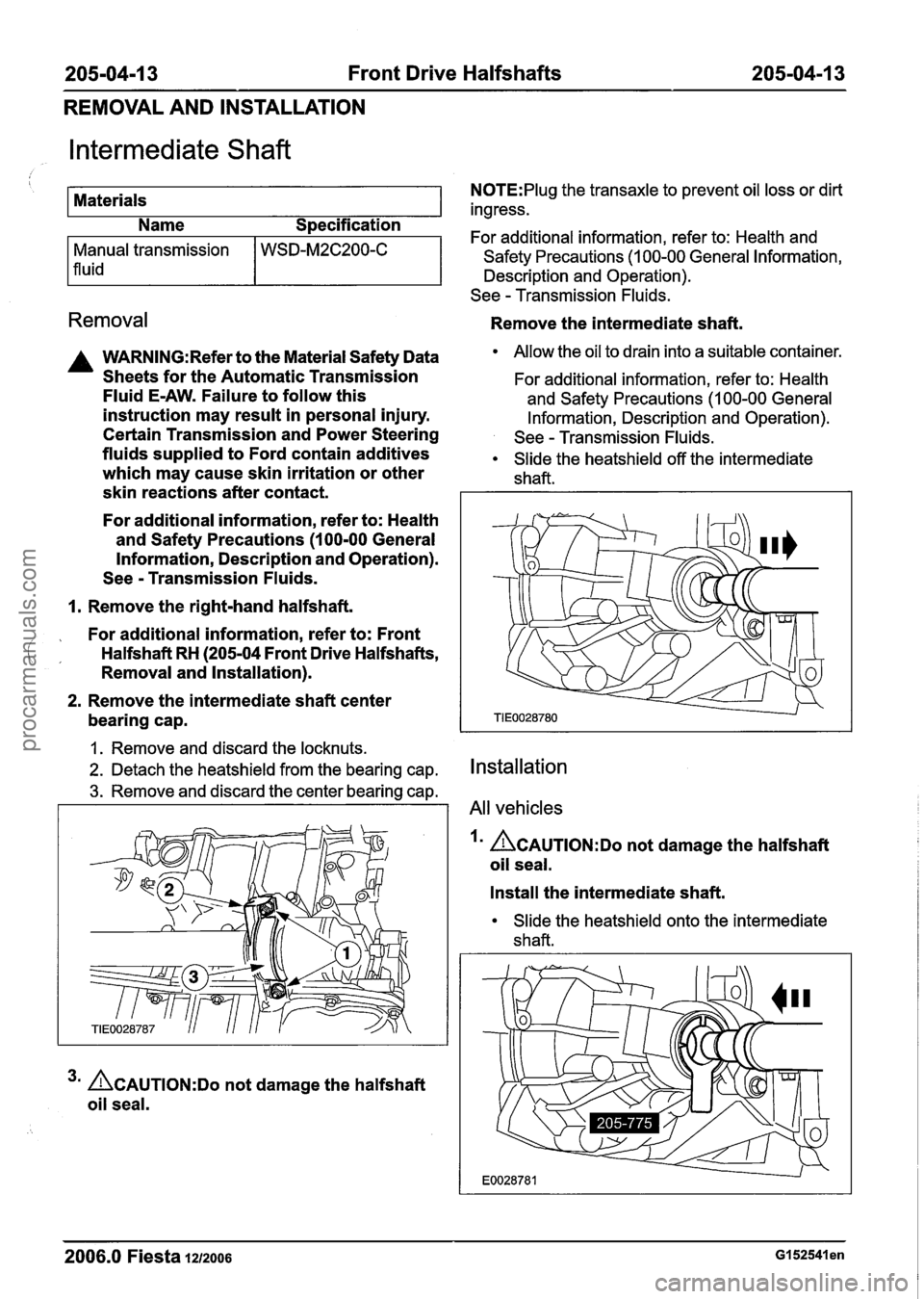
205-04-1 3 Front Drive Halfshafts 205-04-1 3
REMOVAL AND INSTALLATION
Intermediate Shaft
I
Materials
Name Specification
Removal
Manual transmission
1 fluid
A WARN1NG:Refer to the Material Safety Data
Sheets for the Automatic Transmission
Fluid E-AW. Failure to follow this
instruction may result in personal injury.
Certain Transmission and Power Steering
fluids supplied to Ford contain additives
which may cause skin irritation or other
skin reactions after contact.
WSD-M2C200-C
For additional information, refer to: Health
and Safety Precautions
(1 00-00 General
Information, Description and Operation).
See
- Transmission Fluids.
I. Remove the right-hand halfshaft.
, For additional information, refer to: Front
i, Halfshaft RH (205-04 Front Drive Halfshafts,
Removal and Installation).
2. Remove the intermediate shaft center
bearing cap.
1. Remove and discard the locknuts.
2. Detach the heatshield from the bearing cap.
3. Remove and discard the center bearing cap.
3m ACAUTION:D~ not damage the halfshaft
oil seal.
N0TE:Plug the transaxle to prevent oil loss or dirt
ingress.
For additional information, refer to: Health and
Safety Precautions
(1 00-00 General Information,
Description and Operation).
See
- Transmission Fluids.
Remove the intermediate shaft.
Allow the oil to drain into a suitable container.
For additional information, refer to: Health
and Safety Precautions
(I 00-00 General
Information, Description and Operation).
See
- Transmission Fluids.
Slide the heatshield off the intermediate
shaft.
Installation
All vehicles
I' ACAUTION:D~ not damage the halfshaft
oil seal.
Install the intermediate shaft.
Slide the heatshield onto the intermediate
shaft.
2006.0 Fiesta 1212006 GI 52541 en
procarmanuals.com
Page 166 of 1226
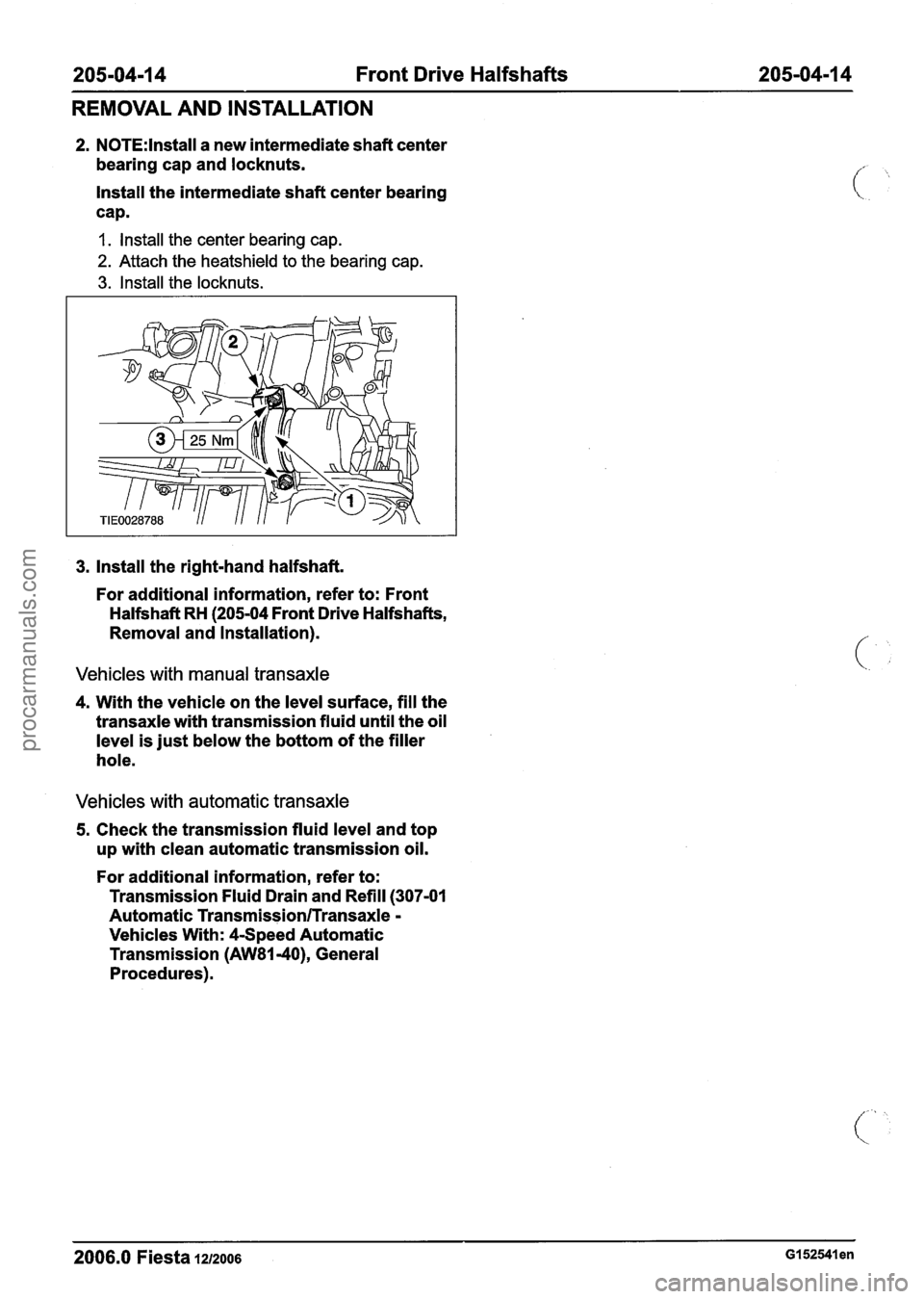
205-04-1 4 Front Drive Halfshafts 205-04-1 4
REMOVAL AND INSTALLATION
2. N0TE:lnstall a new intermediate shaft center
bearing cap and locknuts.
Install the intermediate shaft center bearing
cap.
I. Install the center bearing cap.
2. Attach the heatshield to the bearing cap.
3. Install the locknuts.
3. Install the right-hand halfshaft.
For additional information, refer to: Front
Halfshaft RH (205-04 Front Drive Halfshafts,
Removal and Installation).
Vehicles with manual transaxle
4. With the vehicle on the level surface, fill the
transaxle with transmission fluid until the oil
level is just below the bottom of the filler
hole.
Vehicles with automatic transaxle
5. Check the transmission fluid level and top
up with clean automatic transmission oil.
For additional information, refer to:
Transmission Fluid Drain and Refill
(307-01
Automatic Transmission/Transaxle -
Vehicles With: 4-Speed Automatic
Transmission
(AW81-40), General
Procedures).
2006.0 Fiesta 1212006 GI 52541 en
procarmanuals.com
Page 174 of 1226
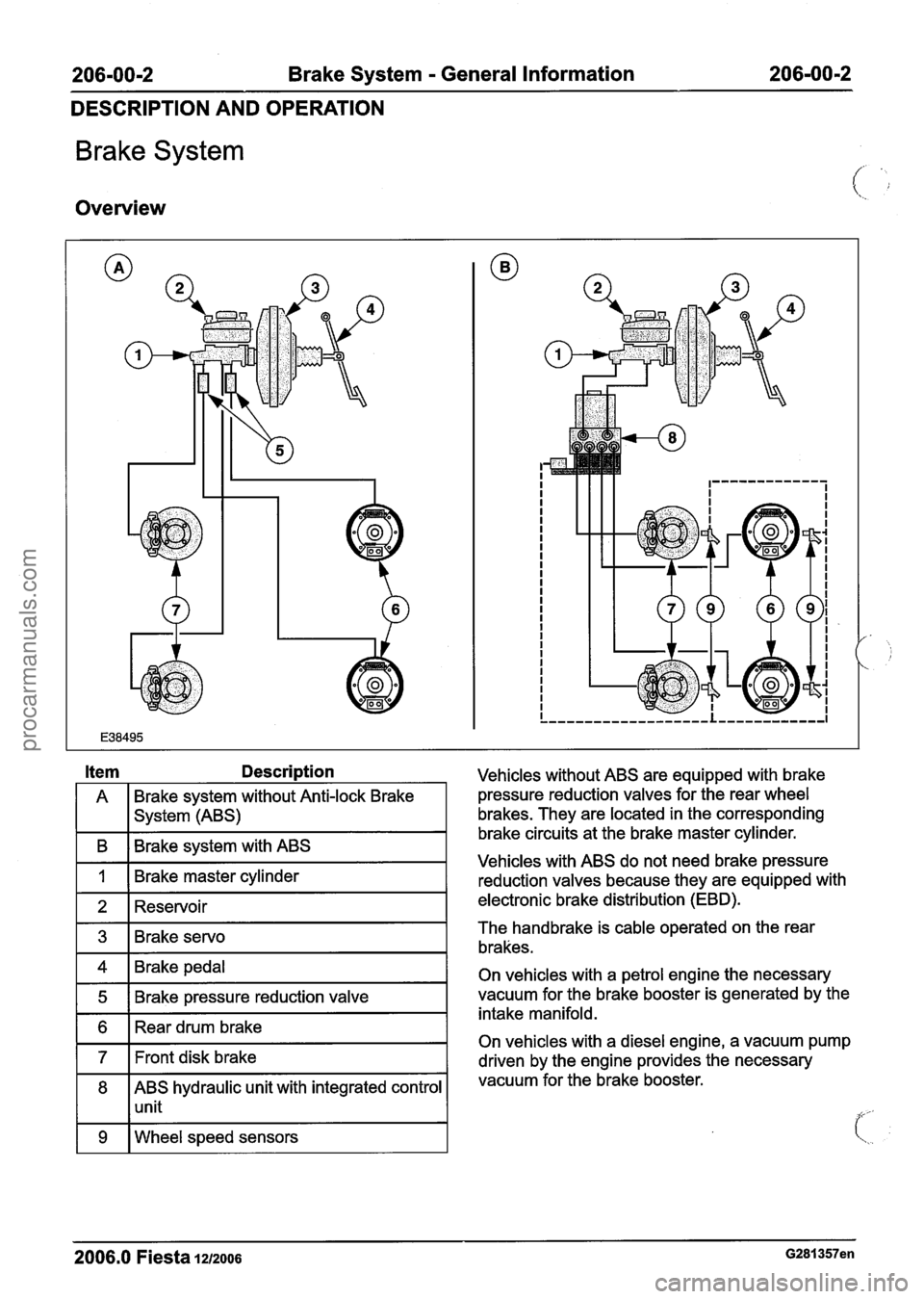
206-00-2 Brake System - General Information 206-00-2
DESCRIPTION AND OPERATION
Brake System
Overview
A Brake system without Anti-lock
Brake
I I system (ABS)
I B I Brake system with ABS I
I 1 I Brake master cylinder I -
1 2 1 Reservoir I
1 4 1 Brake pedal I
1 5 1 Brake pressure reduction valve I
1 6 1 Rear drum brake I
171t disk brake I
8 ABS hydraulic unit with integrated control
1 1 unit
1 9 I Wheel speed sensors I
Vehicles without ABS are equipped with brake
pressure reduction valves for the rear wheel
brakes. They are located in the corresponding
brake circuits at the brake master cylinder.
Vehicles with ABS do not need brake pressure
reduction valves because they are equipped with
electronic brake distribution (EBD).
The handbrake is cable operated on the rear
brakes.
On vehicles with a petrol engine the necessary
vacuum for the brake booster is generated by the
intake manifold.
On vehicles with a diesel engine, a vacuum pump
driven by the engine provides the necessary
vacuum for the brake booster.
2006.0 Fiesta lu2006 G281357en
procarmanuals.com
Page 175 of 1226
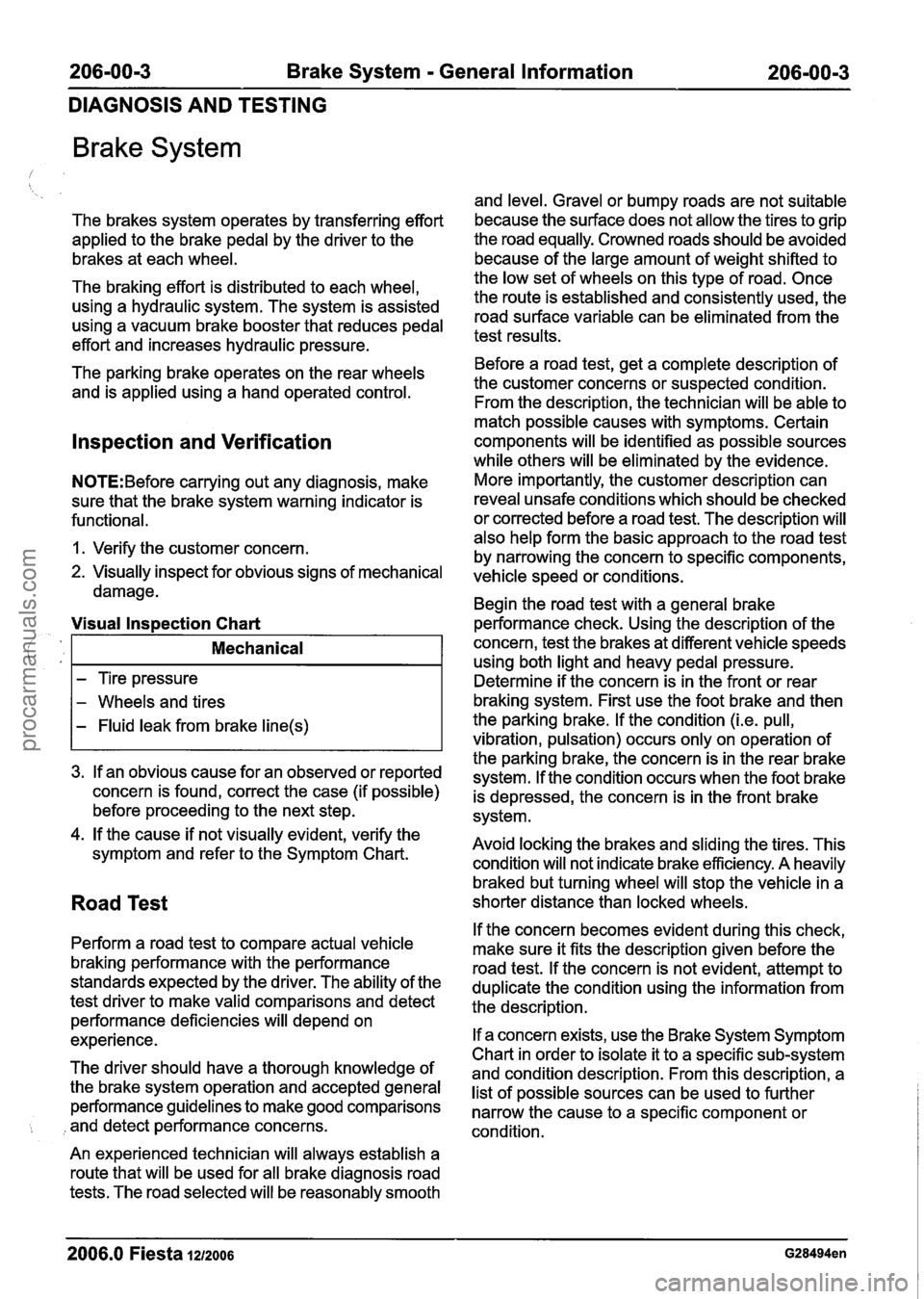
206-00-3 Brake System - General Information 206-00-3
DIAGNOSIS AND TESTING
Brake System
The brakes system operates by transferring effort
applied to the brake pedal by the driver to the
brakes at each wheel.
The braking effort is distributed to each wheel,
using a hydraulic system. The system is assisted
using a vacuum brake booster that reduces pedal
effort and increases hydraulic pressure.
The parking brake operates on the rear wheels
and is applied using a hand operated control.
lnspection and Verification
N0TE:Before carrying out any diagnosis, make
sure that the brake system warning indicator is
functional.
1. Verify the customer concern.
2. Visually inspect for obvious signs of mechanical
damage.
3. If an obvious cause for an observed or reported
concern is found, correct the case (if possible)
before proceeding to the next step.
4. If the cause if not visually evident, verify the
symptom and refer to the Symptom Chart.
Visual lnspection Chart
Road Test
1.
Perform a road test to compare actual vehicle
braking performance with the performance
standards expected by the driver. The ability of the
test driver to make valid comparisons and detect
performance deficiencies will depend on
experience.
Mechanical
- Tire pressure
- Wheels and tires
- Fluid leak from brake line(s)
The driver should have a thorough knowledge of
the brake system operation and accepted general
performance guidelines to make good comparisons
, and detect performance concerns.
An experienced technician will always establish a
route that will be used for all brake diagnosis road
tests. The road selected will be reasonably smooth and level. Gravel
or bumpy roads are not suitable
because the surface does not allow the tires to grip
the road equally. Crowned roads should be avoided
because of the large amount of weight shifted to
the low set of wheels on this type of road. Once
the route is established and consistently used, the
road surface variable can be eliminated from the
test results.
Before a road test, get a complete description of
the customer concerns or suspected condition.
From the description, the technician will be able to
match possible causes with symptoms. Certain
components will be identified as possible sources
while others will be eliminated by the evidence.
More importantly, the customer description can
reveal unsafe conditions which should be checked
or corrected before a road test. The description will
also help form the basic approach to the road test
by narrowing the concern to specific components,
vehicle speed or conditions.
Begin the road test with a general brake
performance check. Using the description of the
concern, test the brakes at different vehicle speeds
using both light and heavy pedal pressure.
Determine if the concern is in the front or rear
braking system. First use the foot brake and then
the parking brake. If the condition
(i.e. pull,
vibration, pulsation) occurs only on operation of
the parking brake, the concern is in the rear brake
system.
If the condition occurs when the foot brake
is depressed, the concern is in the front brake
system.
Avoid locking the brakes and sliding the tires. This
condition will not indicate brake efficiency. A heavily
braked but turning wheel will stop the vehicle in a
shorter distance than locked wheels.
If the concern becomes evident during this check,
make sure it fits the description given before the
road test. If the concern is not evident, attempt to
duplicate the condition using the information from
the description.
If a concern exists, use the Brake System Symptom
Chart in order to isolate it to a specific sub-system
and condition description. From this description, a
list of possible sources can be used to further
narrow the cause to a specific component or
condition.
- -
2006.0 Fiesta 1212006 G28494en
procarmanuals.com
Page 180 of 1226
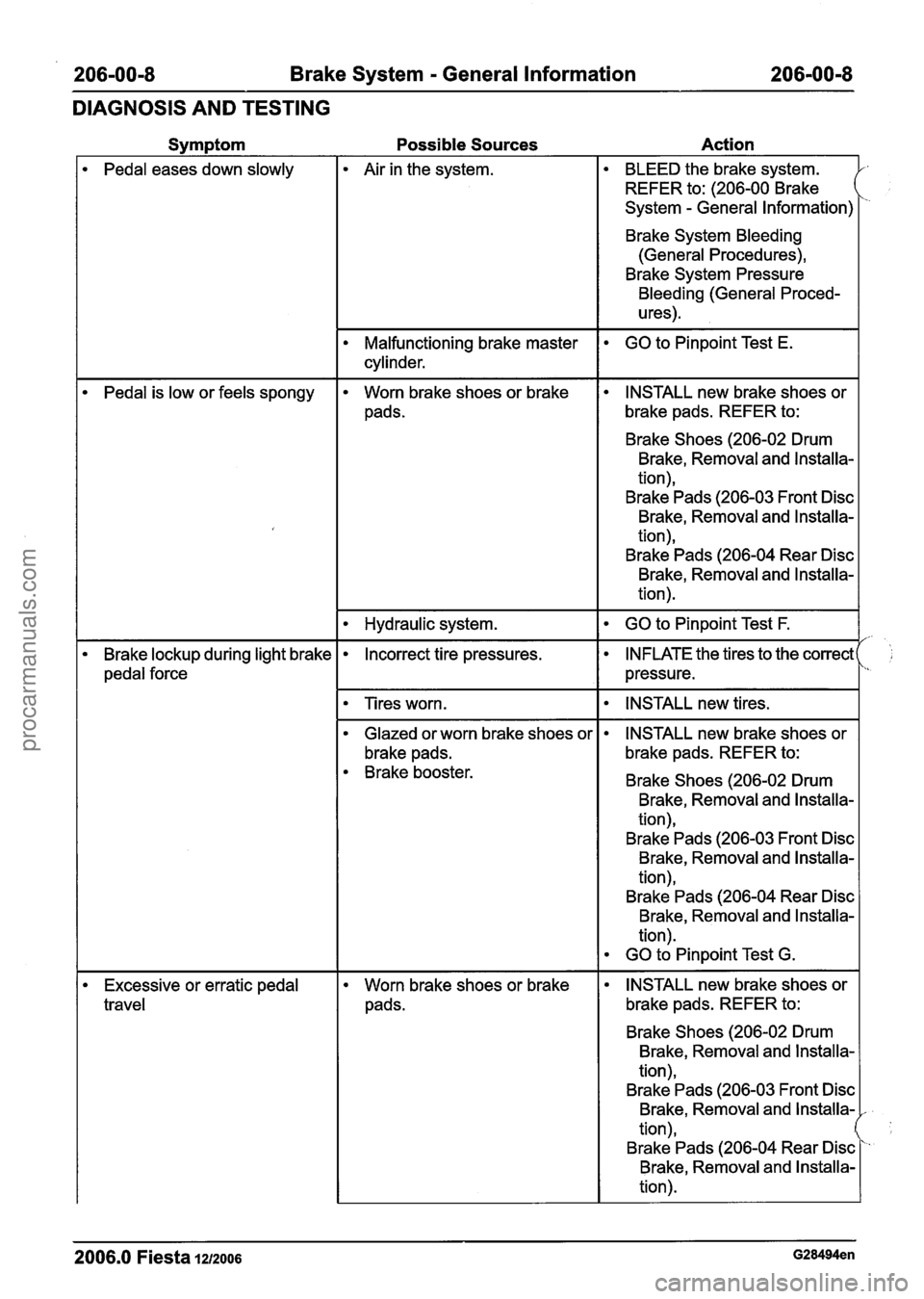
206-00-8 Brake System - General Information 206-00-8
DIAGNOSIS AND TESTING
Svm~tom Possible Sources Action
Pedal eases down slowly Air in the system.
Malfunctioning brake master
cylinder.
BLEED the brake system.
REFER to: (206-00 Brake
System
- General Information)
Brake System Bleeding (General Procedures),
Brake System Pressure Bleeding (General Proced-
ures).
GO to Pinpoint Test E.
Brake, Removal and Installa-
tion),
Brake Pads (206-03 Front Disc
Brake, Removal and Installa-
tion),
Brake Pads (206-04 Rear Disc
Brake, Removal and Installa-
Pedal is low or feels spongy
I tion). I
Brake lockup during light brake I
Worn brake shoes or brake
pads.
pedal force INSTALL new brake shoes or
brake pads. REFER to:
Hydraulic system.
Incorrect tire pressures.
Tires worn.
Glazed or worn brake shoes or
brake pads.
Brake booster.
GO to Pinpoint Test F. I
INFLATE the tires to the correct
pressure.
INSTALL new tires. I
brake pads. REFER to:
Brake Shoes (206-02 Drum
Brake, Removal and Installa-
tion),
Brake Pads (206-03 Front Disc Brake, Removal and Installa-
tion),
Brake Pads (206-04 Rear Disc
Brake, Removal and Installa-
tion).
GO to Pinpoint Test G.
Excessive or erratic pedal
travel Worn brake shoes or brake
pads. INSTALL new brake shoes or
brake pads. REFER to:
Brake Shoes (206-02 Drum Brake, Removal and Installa-
tion),
Brake Pads (206-03 Front Disc Brake, Removal and Installa-
tion),
I
Brake Pads (206-04 Rear Disc
Brake, Removal and Installa-
tion).
2006.0 Fiesta 1212006 G28494en
procarmanuals.com
Page 192 of 1226

206-00-20 Brake System - General Information 206=00-20
DIAGNOSIS AND TESTING
TEST CONDITIONS
DETAILSIRESULTSIACTIONS
F4: BLEED THE BRAKE SYSTEM
rn Check for air in the brake system. Bleed the
brake system. REFER to: (206-00 Brake System
- General lnformation)
Brake System Bleeding (General Procedures),
Brake System Pressure Bleeding (General Procedures)
.
Is the condition still present?
+ Yes
GO to F5.
+ No
Vehicle OK.
F5: CHECK FRONT WHEEL HUB RETAINING NUT
Check the front wheel hub retaining nut for
looseness.
Is the front wheel hub retaining nut loose?
+ Yes
INSTALL a new front wheel hub retaining nut.
REFER to: Specifications (204-01 Front
Suspension, Specifications).
Do not reuse the
frontwheel hub retaining nut.
TEST the system for normal operation.
+ No
CHECK the parking bake adjustment. REFER
to: (206-05 Parking Brake and Actuation)
Parking Brake Cable Adjustment
- Vehicles With:
Rear Drum Brakes (General Procedures),
Parking Brake Cable Adjustment
- Vehicles With:
Rear Disc Brakes (General Procedures).
PINPOINT TEST G
: BRAKE LOCK UP DURING LIGHT BRAKE PEDAL FORCE
TEST CONDITIONS
DETAILSIRESULTSIACTIONS
I GI : ROAD TEST-THE VEHICLE I
Road test the vehicle and apply the brake pedal
lightly.
Do the rear brakes lock up?
+ Yes
GO to G2. GO to Pinpoint Test G.
+ No
Vehicle OK.
2006.0 Fiesta 12/2006 G28494en
procarmanuals.com
Page 202 of 1226
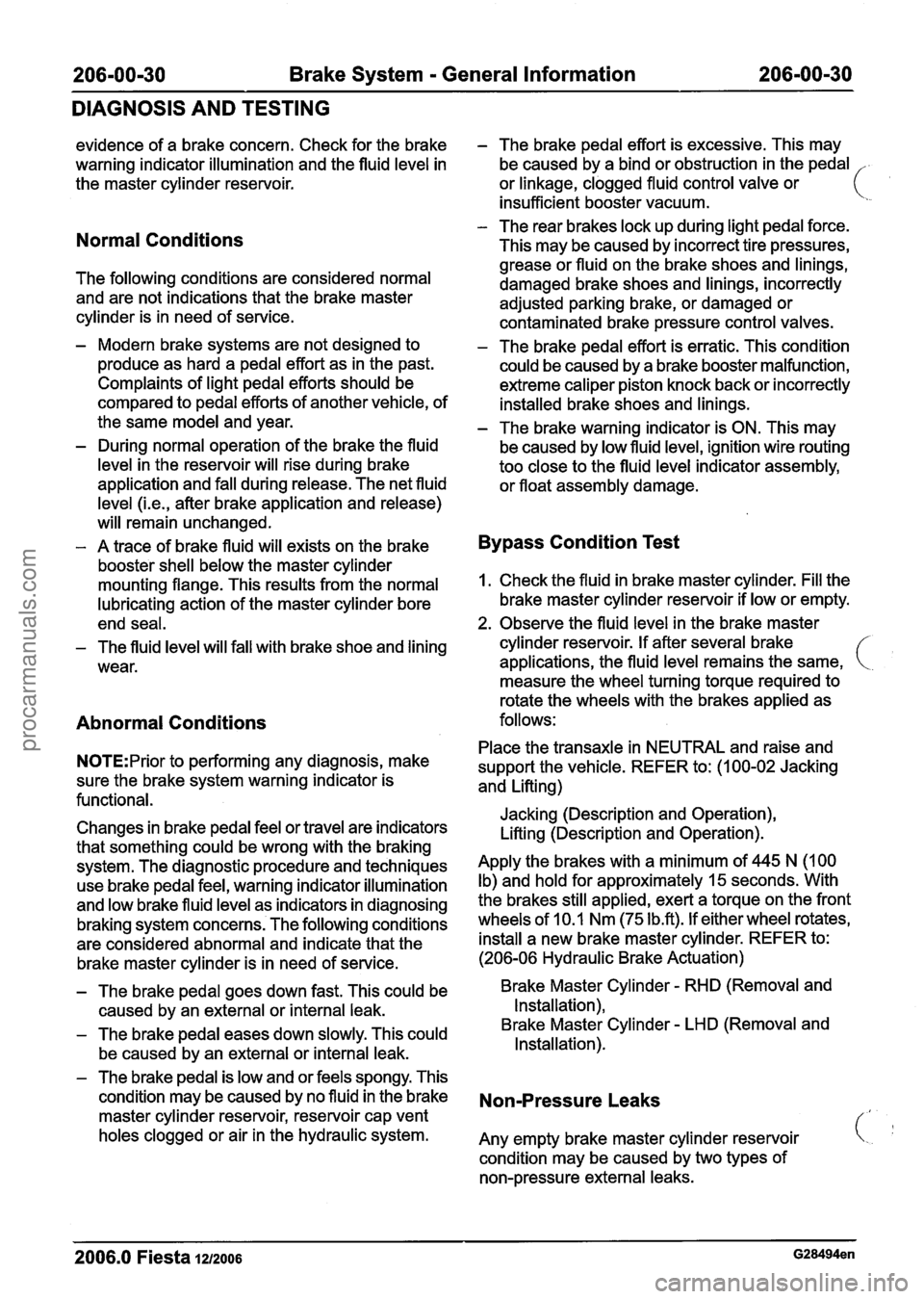
Brake System - General Information
DIAGNOSIS AND TESTING
evidence of a brake concern. Check for the brake
warning indicator illumination and the fluid level in
the master cylinder reservoir.
Normal Conditions
The following conditions are considered normal
and are not indications that the brake master
cylinder is in need of service.
- Modern brake systems are not designed to
produce as hard a pedal effort as in the past.
Complaints of light pedal efforts should be
compared to pedal efforts of another vehicle, of
the same model and year.
- During normal operation of the brake the fluid
level in the reservoir will rise during brake
application and fall during release. The net fluid
level
(i.e., after brake application and release)
will remain unchanged.
- A trace of brake fluid will exists on the brake
booster shell below the master cylinder
mounting flange. This results from the normal
lubricating action of the master cylinder bore
end seal.
- The fluid level will fall with brake shoe and lining
wear.
Abnormal Conditions
N0TE:Prior to performing any diagnosis, make
sure the brake system warning indicator is
functional.
Changes in brake pedal feel or travel are indicators
that something could be wrong with the braking system. The diagnostic procedure and techniques
use brake pedal feel, warning indicator illumination
and low brake fluid level as indicators in diagnosing
braking system concerns. The following conditions
are considered abnormal and indicate that the
brake master cylinder is in need of service.
- The brake pedal effort is excessive. This may
be caused by a bind or obstruction in the pedal
.
or linkage, clogged fluid control valve or ( ' insufficient booster vacuum.
- The rear brakes lock up during light pedal force.
This may be caused by incorrect tire pressures,
grease or fluid on the brake shoes and linings,
damaged brake shoes and linings, incorrectly
adjusted parking brake, or damaged or
contaminated brake pressure control valves.
- The brake pedal effort is erratic. This condition
could be caused by a brake booster malfunction,
extreme caliper piston knock back or incorrectly
installed brake shoes and linings.
- The brake warning indicator is ON. This may
be caused by low fluid level, ignition wire routing
too close to the fluid level indicator assembly,
or float assembly damage.
Bypass Condition Test
1. Check the fluid in brake master cylinder. Fill the
brake master cylinder reservoir if low or empty.
2. Observe the fluid level in the brake master
cylinder reservoir. If after several brake
applications, the fluid level remains the same,
measure the wheel turning torque required to
rotate the wheels with the brakes applied as
follows:
Place the transaxle in NEUTRAL and raise and
support the vehicle. REFER to: (1 00-02 Jacking
and Lifting)
Jacking (Description and Operation),
Lifting (Description and Operation).
Apply the brakes with a minimum of 445 N (100
Ib) and hold for approximately 15 seconds. With
the brakes still applied, exert a torque on the front
wheels of 10.1 Nm (75
1b.R). If either wheel rotates,
install a new brake master cylinder. REFER to:
(206-06 Hydraulic Brake Actuation)
- The brake pedal goes down fast. This could be Brake Master Cylinder - RHD (Removal and
caused by an external or internal leak. Installation),
- The brake
pedal eases down slowly. This could Brake Master Cylinder - LHD
(Removal and
be caused by an external or internal leak. Installation).
- The
brake pedal is low and or feels spongy. This
condition may be caused by no fluid in the brake
Non-Pressure Leaks master cylinder reservoir, reservoir cap vent
holes clogged or air in the hydraulic system.
Any empty brake master cylinder reservoir
condition may be caused by two types of
non-pressure external leaks.
2006.0 Fiesta 1212006
procarmanuals.com